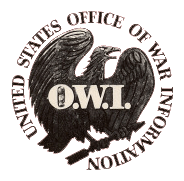On June 13, 1942 Executive Order 9182 under President Franklin D. Roosevelt created the United States Office of War Information (OWI). The OWI was seen as the connection between the battlefront and civilians back home. Its purpose was to centralize the various information services of the U.S. government. The OWI not only created a single stream of information but it created and distributed posters, booklets, photographs, films and radio shows.
 With this executive order the agencies, powers, and duties were transferred and consolidated into the Office of War Information: The Office of Facts and Figures, The Office of Government Reports and the Coordinator of Information were assigned to the Foreign Information Service, Outpost, Publications, and Pictorial Branches.
With this executive order the agencies, powers, and duties were transferred and consolidated into the Office of War Information: The Office of Facts and Figures, The Office of Government Reports and the Coordinator of Information were assigned to the Foreign Information Service, Outpost, Publications, and Pictorial Branches.
After the attack on Pearl Harbor, President Roosevelt named CBS newsman and journalist Elmer Davis as the director of the OWI. Davis was charged with creating and carrying out through the newspaper, radio, motion pictures and other facilities, information programs designed to inform and create an understanding for the U.S. citizens home and abroad.
According to Elmer Davis, “The easiest way to inject a propaganda idea into most people’s minds is to let it go through the medium of an entertainment picture when they do not realize that they are being propagandized.”
Though with many things came controversy, Davis wrote to George C. Marshall on March 27, 1944, “You have probably seen Governor Dewey’s reference to the incident of the shooting down of the transport planes in Sicily last July, which he chooses to treat as an instance of a deliberate policy of suppression of news.” Marshall responded on March 30, 1944, “…It is a matter of concern to me no less than to you that the public should be completely informed of military operations so long as security is not adversely affected. The more the public understands our difficulties and the ways we are meeting them, the better, from my personal point of view.”
Marshall understood the importance of the American public both at home and broad to get the correct information about what was going on. On November 23, 1944 Marshall received word that Elmer Davis objected to the release of “Two Down and One To Go.” Marshall replied on November 24, 1944, “A great deal of thought and planning has been given to this film, since it must serve the purpose of presenting clearly to the troops and to the American public a very important, but very complicated, subject…Moreover, it seems to me particularly important that the film shown to the public should be identical with that shown to the troops.”
To learn more about Marshall’s support of films throughout the war, be sure to visit our new museum exhibit Marshall and Goes to the Movies.
